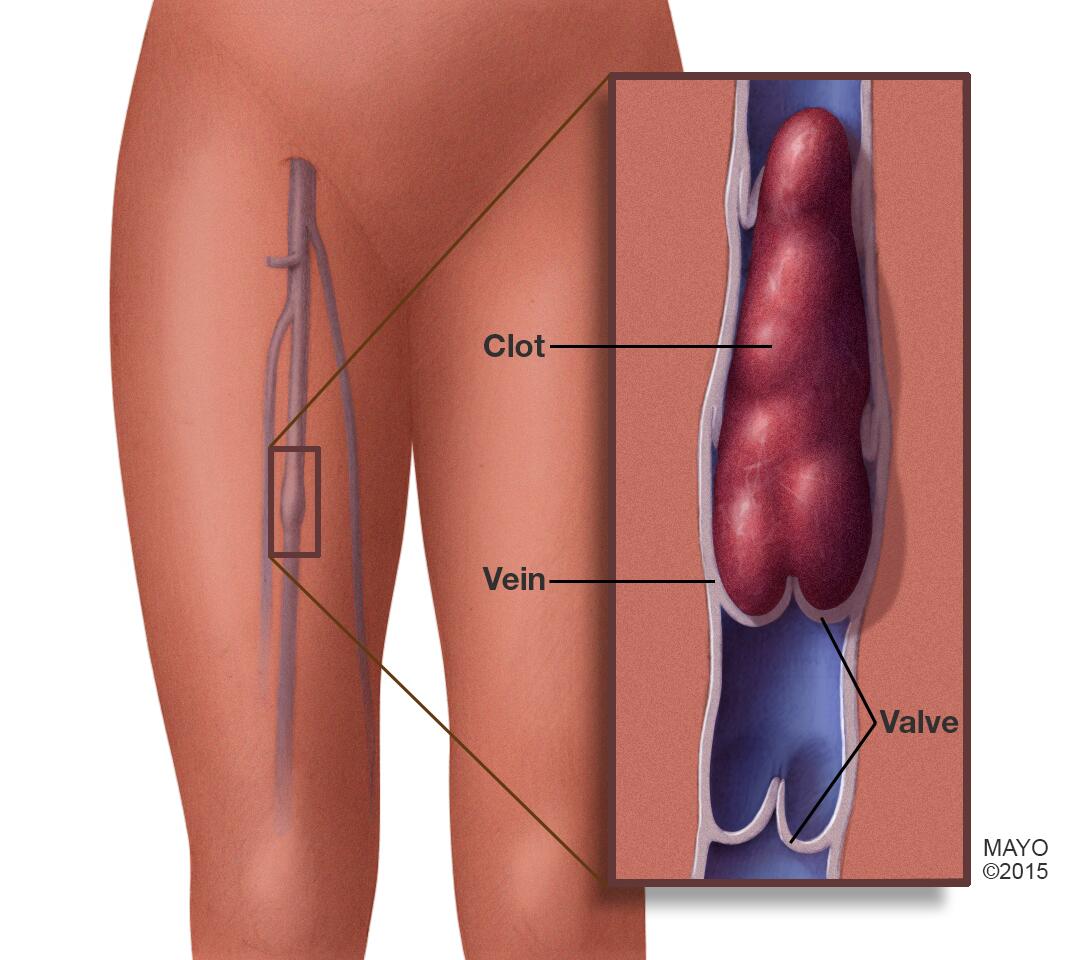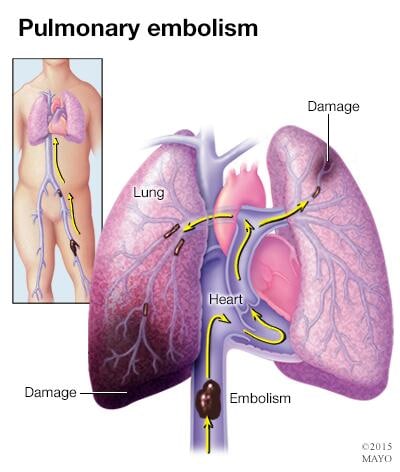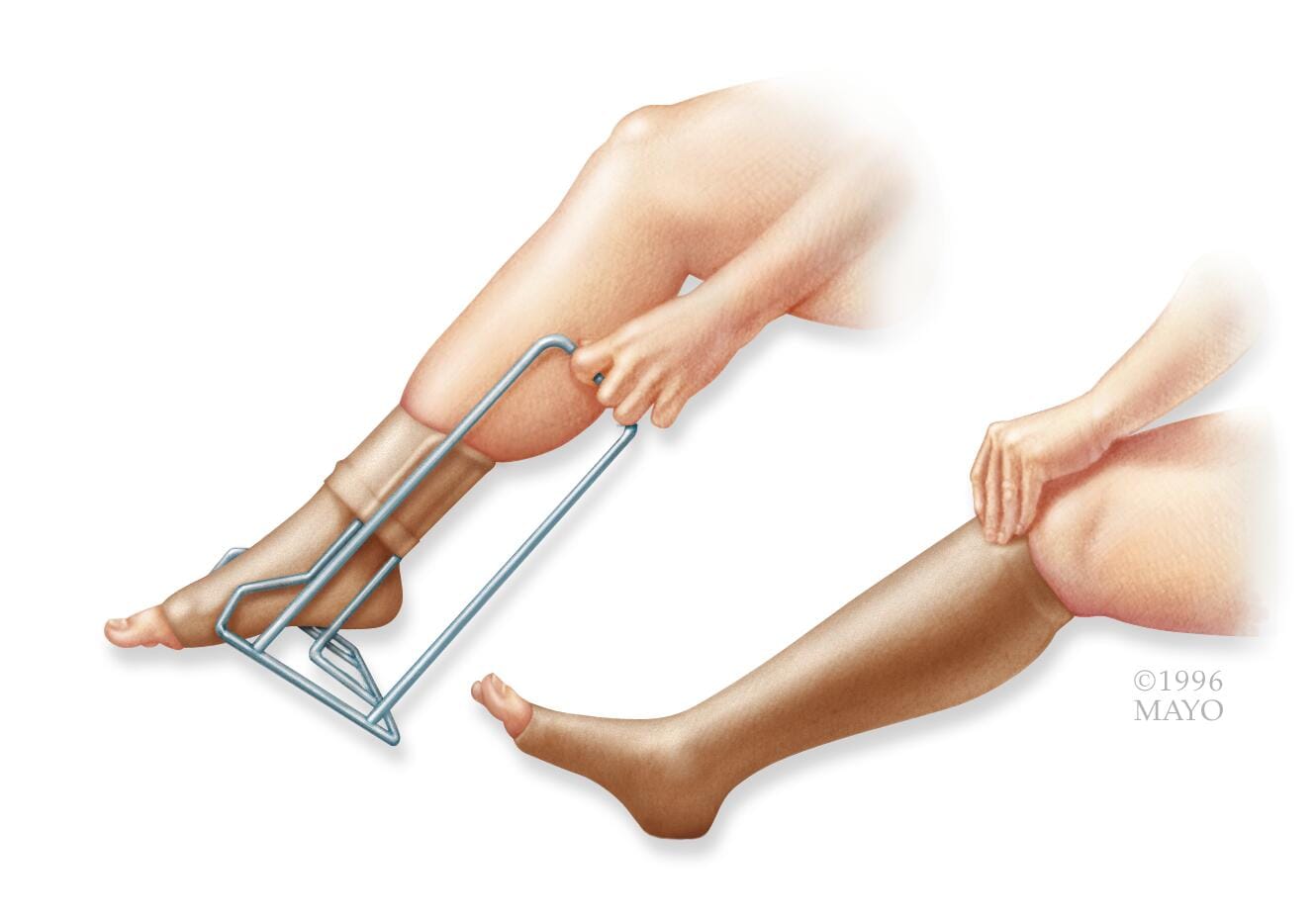Thrombophlebitis
Overview
Thrombophlebitis (throm-boe-fluh-BY-tis) is an inflammatory process that causes a blood clot to form and block one or more veins, usually in the legs. The affected vein might be near the surface of the skin (superficial thrombophlebitis) or deep within a muscle (deep vein thrombosis, or DVT).
Causes of thrombophlebitis include trauma, surgery or prolonged inactivity.
Deep vein thrombosis (DVT) increases the risk of serious health problems. It's usually treated with blood-thinning medications. Superficial thrombophlebitis is sometimes treated with blood-thinning medications, too.

Symptoms
Superficial thrombophlebitis signs and symptoms include:
- Warmth, tenderness and pain in the affected area
- Redness and swelling
Deep vein thrombosis signs and symptoms include:
- Pain
- Swelling
When a vein close to the surface of the skin is affected, you might see a red, hard cord just under the surface of the skin that's tender to the touch. When a deep vein in the leg is affected, the leg may become swollen, tender and painful.
When to see a doctor
See your doctor right away if you have a red, swollen or tender vein — especially if you have one or more risk factors for thrombophlebitis.
Call 911 or your local emergency number if:
- The vein swelling and pain are severe
- You also have shortness of breath or chest pain, are coughing up blood, or have other symptoms that may indicate a blood clot traveling to your lungs (pulmonary embolism)
Have someone take you to your doctor or emergency room, if possible. It might be difficult for you to drive, and it's helpful to have someone with you to help you remember the information you receive.
Causes
The cause of thrombophlebitis is a blood clot, which can form in your blood as a result of:
- An injury to a vein
- An inherited blood-clotting disorder
- Being immobile for long periods, such as during an injury or a hospital stay
Risk factors
Your risk of thrombophlebitis might increase if you:
- Are inactive for a prolonged period, either because you're confined to bed or you're traveling in a car or plane for a long period
- Have varicose veins, which are a common cause of superficial thrombophlebitis
- Have a pacemaker or have a thin, flexible tube (catheter) in a central vein, for treatment of a medical condition, which may irritate the blood vessel wall and decrease blood flow
- Are pregnant or have just given birth
- Use birth control pills or hormone replacement therapy, which can make your blood more likely to clot
- Have a family history of a blood-clotting disorder or a tendency to form blood clots
- Have had previous episodes of thrombophlebitis
- Have had a stroke
- Are older than 60
- Are overweight or obese
- Have cancer
- Smoke
If you have one or more risk factors, discuss prevention strategies with your doctor before taking long flights or road trips or if you're planning to have elective surgery, recovery from which will require you not to move much.
Complications
Complications from superficial thrombophlebitis are rare. However, if you develop DVT, the risk of serious complications increases. Complications might include:
- Blood clot in the lungs (pulmonary embolism). If part of a deep vein clot becomes dislodged, it can travel to your lungs, where it can block an artery (embolism) and become potentially life-threatening.
- Lasting leg pain and swelling (post-phlebetic syndrome). This condition, also known as post-thrombotic syndrome, can develop months or years after you've had DVT. The pain can be disabling.

Prevention
Sitting during a long flight or car ride can cause your ankles and calves to swell and increases your risk of thrombophlebitis. To help prevent a blood clot:
- Take a walk. If you're flying or riding a train or bus, walk up and down the aisle once an hour or so. If you're driving, stop every hour or so and move around.
- Move your legs regularly. Flex your ankles, or carefully press your feet against the floor or footrest in front of you at least 10 times each hour.
- Drink plenty of water or other nonalcoholic fluids to avoid dehydration.
Diagnosis
To diagnose thrombophlebitis, your doctor will ask you about your discomfort and look for affected veins near your skin's surface. To determine whether you have superficial thrombophlebitis or deep vein thrombosis, your doctor might choose one of these tests:
-
Ultrasound. A wandlike device (transducer) moved over the affected area of your leg sends sound waves into your leg. As the sound waves travel through your leg tissue and reflect back, a computer transforms the waves into a moving image on a video screen.
This test can confirm the diagnosis and distinguish between superficial and deep vein thrombosis.
-
Blood test. Almost everyone with a blood clot has an elevated blood level of a naturally occurring, clot-dissolving substance called D dimer. But D dimer levels can be elevated in other conditions. So a test for D dimer isn't conclusive, but can indicate the need for further testing.
It's also useful for ruling out DVT and for identifying people at risk of developing thrombophlebitis repeatedly.
Treatment
For superficial thrombophlebitis, your doctor might recommend applying heat to the painful area, elevating the affected leg, using an over-the-counter nonsteroidal anti-inflammatory drug (NSAID) and possibly wearing compression stockings. The condition usually improves on its own.
Your doctor might also recommend these treatments for both types of thrombophlebitis:
- Blood-thinning medications. If you have deep vein thrombosis, injection of a blood-thinning (anticoagulant) medication, such as low molecular weight heparin, fondaparinux (Arixtra) or apixaban (Eliquis), can help prevent clots from growing bigger. After the first treatment, you'll likely be told to take warfarin (Jantoven) or rivaroxaban (Xarelto) for several months to keep preventing clot growth. Blood thinners can cause excessive bleeding. Always follow your doctor's instructions carefully.
- Clot-dissolving medications. Treatment with a clot-dissolving drug is called thrombolysis. The medication alteplase (Activase) is used to dissolve blood clots in people with extensive DVT, including those who have a blood clot in the lungs (pulmonary embolism).
- Compression stockings. Prescription-strength compression stockings help prevent swelling and reduce the chances of complications of DVT.
- Vena cava filter. If you can't take blood thinners, a filter may be inserted into the main vein in your abdomen (vena cava) to prevent clots that break loose in leg veins from lodging in your lungs. Usually, the filter is removed when it's no longer needed.
- Varicose vein stripping. A surgeon can remove varicose veins that cause pain or recurrent thrombophlebitis. The procedure involves removing a long vein through small incisions. Removing the vein won't affect blood flow in your leg because veins deeper in the leg take care of the increased volumes of blood.

Self care
In addition to medical treatments, self-care measures can help improve thrombophlebitis.
If you have superficial thrombophlebitis:
- Use a warm washcloth to apply heat to the involved area several times daily
- Keep your leg raised when sitting or lying down
- Use a nonsteroidal anti-inflammatory drug (NSAID), such as ibuprofen (Advil, Motrin IB, others) or naproxen sodium (Aleve, others), if recommended by your doctor
Let your doctor know if you're taking another blood thinner, such as aspirin.
If you have deep vein thrombosis:
- Take prescription blood-thinning medications as directed to prevent complications
- Keep your leg raised when sitting or lying down if it's swollen
- Wear your prescription-strength compression stockings as directed
Preparing for your appointment
If you have time before your appointment, here's some information to help you get ready.
What you can do
Make a list of:
- Your symptoms, including any that may seem unrelated to the reason for your appointment
- Key personal information, including a family history of blood-clotting disorders or long periods of inactivity recently, such as a car or plane trip
- All medications, vitamins or other supplements you take
- Questions to ask your doctor
For thrombophlebitis, basic questions to ask your doctor include:
- What is likely causing my condition?
- What are other possible causes?
- What tests do I need?
- What treatments are available and which do you recommend?
- I have other health conditions. How can I best manage these conditions together?
- Are there dietary or activity restrictions I need to follow?
- Are there brochures or other printed material I can have? What websites do you recommend?
What to expect from your doctor
Your doctor is likely to ask you questions, such as:
- When did your symptoms begin?
- Do you have symptoms all the time, or do they come and go?
- How severe are your symptoms?
- Have you had an injury or surgery within the past three months?
- What, if anything, seems to improve or worsen your symptoms?
Last Updated Sep 5, 2023
© 2024 Mayo Foundation for Medical Education and Research (MFMER). All rights reserved. Terms of Use